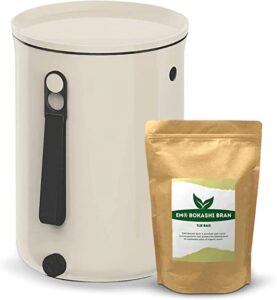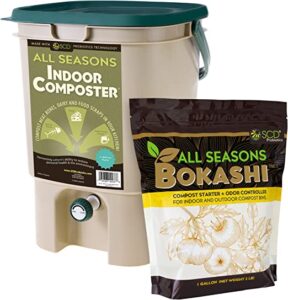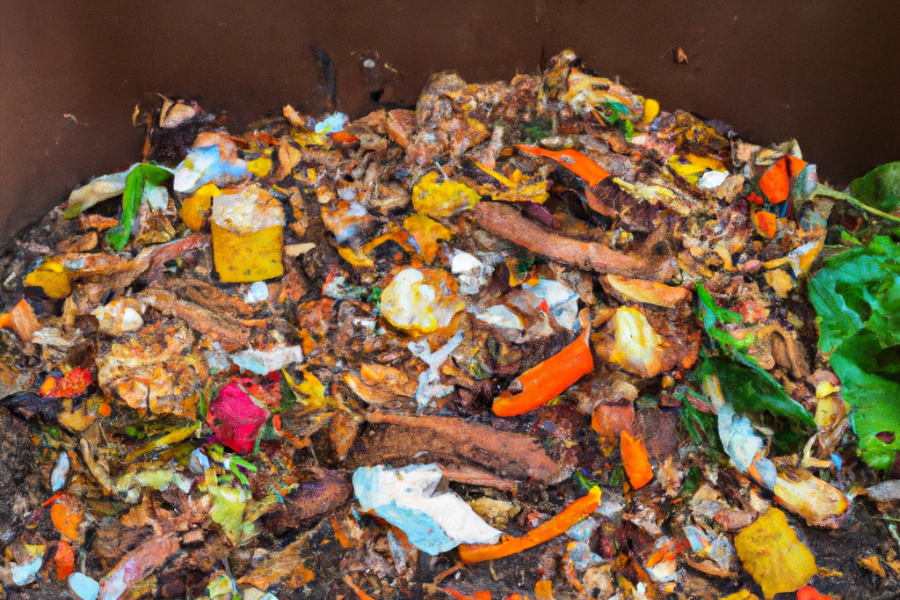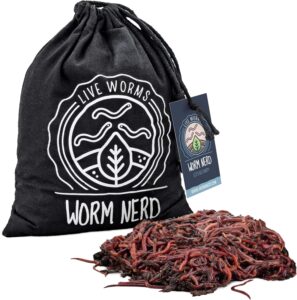Introduction to Bokashi Composting
The art of Bokashi composting is like discovering a superpower you didn’t know you had. Ever found yourself dismayed by the mountains of food waste generated in your kitchen every day? What if I told you there’s a way to turn that ‘waste’ into valuable, nutrient-rich compost for your garden? Bokashi composting, my friends, is that superhero cape you didn’t know you needed.
Hailing originally from Japan, Bokashi composting is a composting method that uses a carefully selected group of microorganisms to break down organic material rapidly. But hold up; we’re not talking about a slow, drawn-out decomposition process here. Nope, these little microbial workers operate in a sealed environment and do their job with mind-boggling efficiency.
History and Origin of Bokashi Composting
Bokashi composting dates back to ancient times in Asia. It’s like an old secret handed down through the generations, except that it’s not a secret anymore. The term ‘Bokashi’ translates roughly to ‘fermented organic matter’, and it offers a clue into the underlying principles of this process.
Dr. Teruo Higa, a professor at the University of Ryukyus in Okinawa, Japan, deserves credit for bringing Bokashi composting to the forefront of organic farming methods. In the 1980s, he perfected a concoction of beneficial microorganisms that could rapidly break down organic waste, which he named “Effective Microorganisms” (EM). Today, we use this same concept to turn food waste into high-quality compost.
Understanding the Bokashi Composting Process
The Science Behind Bokashi
Underneath the lid of your Bokashi bin, there’s a fascinating microbial disco going on. The hard work of these microscopic partygoers, primarily lactic acid bacteria, yeasts, and phototrophic bacteria, drives the Bokashi process. The key difference between Bokashi composting and other methods is fermentation.
Unlike traditional composting, which relies on aerobic (oxygen-loving) bacteria, Bokashi composting utilizes anaerobic (oxygen-avoiding) bacteria. It’s as if the workers in your Bokashi bin thrive on a strict ‘no oxygen’ policy. In fact, these bacteria are so effective that they prevent the growth of rot-causing organisms, ensuring the process is odor-free and fast.
Steps in Bokashi Composting
Preparing Your Bokashi Bin
First things first, preparing your Bokashi bin is like laying out the red carpet for your microbial workers. You kick-start the process by adding a layer of Bokashi bran at the bottom. The bran has been pre-inoculated with the necessary microorganisms, so it’s a bit like adding the starter culture when making yogurt.
The Layering Process
Next up is layering your organic waste. This can include most kitchen scraps like fruit and vegetable peelings, coffee grounds, tea bags, etc. However, avoid bones and large amounts of meat. The smaller the pieces, the easier it is for our microscopic friends to do their job.
Sealing and Fermentation
Once your waste and bran are in place, it’s time to press down firmly to remove any air and seal the bin. The fermentation stage begins, and it’s best to give the workers some peace and quiet to do their job effectively.
Benefits of Bokashi Composting
Environmental Impact
If you’ve been seeking a way to lessen your carbon footprint, Bokashi composting is your new best friend. By diverting kitchen waste from landfills, you significantly reduce the emission of methane, a potent greenhouse gas. Think of it as a personal contribution to the fight against climate change.
Garden and Soil Health
As a gardener, embracing Bokashi composting is like upgrading to a five-star dining experience for your plants. The resulting compost is a powerhouse of essential nutrients and beneficial microbes. It boosts soil health, improves its structure, and enhances its ability to retain moisture.
Economic Savings
Bokashi composting doesn’t just benefit the planet; it benefits your pocket, too. The cost of commercial fertilizers can add up quickly, particularly if you have a large garden or numerous houseplants. Using your own Bokashi compost instead is like finding free money in your pocket – a pleasant surprise that makes your gardening budget stretch further.
Reduced Waste Production
Bokashi composting can significantly reduce the volume of waste your household sends to landfill. This doesn’t just minimize your environmental impact; it could also reduce your trash disposal costs.
Indoor Composting Capability
One of the beautiful things about Bokashi composting is that it can be done indoors without attracting pests or producing unpleasant odors. This makes it a perfect composting method for urban dwellers or anyone with limited outdoor space.
Highly Versatile Compost
The final product of Bokashi composting is incredibly versatile. It can be used to enrich the soil in your garden, add to potted plants, or make nutrient-rich compost tea. It’s like a multi-tool for gardeners – one product, many uses.
With these additional benefits, it’s clear that Bokashi composting isn’t just a beneficial practice for your garden; it’s a holistic approach to sustainable living that offers multiple rewards.
Troubleshooting Common Bokashi Problems
Bokashi composting is a relatively straightforward process, but like any endeavor, there can be hiccups along the way. Let’s demystify a few common problems and find solutions to keep your composting journey on the right track.
Bad Smell
Bad smells often arise from an imbalance in the composting process. Bokashi compost should have a sweet, fermented odor similar to pickles or cider. If it starts smelling like rotten eggs or spoiled food, that’s a signal something’s off.
Solution: Check that the bin is sealed properly and that you remove as much air as possible when adding new waste. Also, ensure that you’re using enough Bokashi bran with each layer of waste.
White Mold
White mold isn’t necessarily a problem; it can be a sign that the fermentation process works correctly. However, if the mold is green, black, or blue, it indicates an issue.
Solution: Make sure the waste is well-covered with Bokashi bran, and always press down the contents to remove any air pockets. A well-sealed bin is also crucial to prevent undesirable molds.
Fly Infestation
If flies have found their way into your Bokashi bin, it could become a breeding ground for these pesky critters.
Solution: Ensure that your bin is tightly sealed at all times. Also, remember to press down your kitchen waste to remove any air spaces which might attract flies.
Compost is Not Fermenting
If your compost doesn’t seem to be fermenting, it could be due to a lack of effective microorganisms, not enough moisture, or too much oxygen.
Solution: Ensure you are using a quality Bokashi bran, and don’t skimp on it – the more, the merrier! Also, remember to press down each layer to remove air and ensure the contents are in close contact with the Bokashi bran.
Remember, even the most seasoned Bokashi composters occasionally encounter problems. The key is to monitor your compost closely and take swift action when needed. With these troubleshooting tips, you’re well-prepared to maintain a healthy and effective Bokashi composting process.
Choosing the Right Bokashi Starter
Selecting a Bokashi starter is a lot like picking the right teammate for a relay race. You want something with the power, efficiency, and stamina to get you to the finish line. Look for a starter that contains a blend of beneficial microorganisms, including lactic acid bacteria, yeasts, and phototrophic bacteria.
Bokashi Composting Versus Traditional Composting
Comparing Bokashi composting with traditional composting is a bit like comparing apples and oranges – they both serve a purpose, but in very different ways. Let’s delve deeper into how these two composting methods stack up.
Process and Speed
Traditional composting requires a balance of greens (nitrogen-rich materials) and browns (carbon-rich materials) and involves the breakdown of organic material by aerobic bacteria over several weeks or months. It’s a bit like slow cooking – it takes time, but you’ll eventually get a great product.
On the other hand, Bokashi composting is faster and more like pickling, as it involves fermenting kitchen scraps using a special bran that’s inoculated with beneficial microbes. Within two weeks, your kitchen waste can be turned into a rich compost ready for your garden.
Type of Waste Accepted
Traditional composting is somewhat picky when it comes to what it accepts. Dairy, meat, and cooked food are typically no-nos as they can attract pests and produce foul odors.
On the other hand, Bokashi composting is more like that friend who’ll always accept your dinner invitation, no matter what’s on the menu. It can handle almost all types of kitchen waste, including those not recommended for traditional compost piles, like small amounts of dairy and meat.
Odor and Location
Traditional composting can produce a bad smell if not managed properly, making it less suitable for indoor use or small spaces. It’s like having a gym bag you’ve forgotten to empty – not something you’d want inside!
In contrast, Bokashi composting is a bit more like a well-behaved houseguest. It’s neat, and tidy, and doesn’t produce bad smells when done right, making it suitable for indoor use, such as in apartments or small homes.
Impact on the Environment
Regarding environmental impact, both Bokashi and traditional composting play a positive role by recycling kitchen waste into nutrient-rich compost, thereby reducing the amount of waste that ends up in landfills. However, there are some subtle differences between the two.
When done correctly, traditional composting is a natural process that doesn’t require any added inputs other than your kitchen and yard waste. However, if not managed properly, it can release methane – a potent greenhouse gas – into the environment.
On the other hand, Bokashi composting requires the use of Bokashi bran, which must be purchased or made at home. However, the Bokashi process is anaerobic, meaning it doesn’t release any greenhouse gases. Additionally, Bokashi composting has the bonus of producing compost tea, a beneficial liquid fertilizer that can be used to feed houseplants or garden plants.
In terms of sustainability, both methods are excellent ways to reduce waste and contribute to a healthier environment. The choice between Bokashi and traditional composting largely depends on your preferences, available space, and the types of waste you need to compost.
End Product
The end product of traditional composting is compost that looks and smells like rich, dark earth. You can use it immediately in your garden.
Bokashi composting, however, produces a pre-compost that needs to be buried in soil for two weeks before it’s ready to use. The end product is highly nutritious for plants but requires an extra step before use.
So, Bokashi composting or traditional composting? It ultimately comes down to your specific needs, the type of waste you generate, and your living conditions. Both methods offer unique advantages, so choose the one that best resonates with your lifestyle and gardening needs.
How to Use Bokashi Compost in Your Garden
Direct Application
One way to use Bokashi compost is to apply it directly to your garden soil. Think of it as a potent multivitamin supplement for your plants. It’s as simple as digging a hole, adding your fermented Bokashi waste, and covering it with soil.
Compost Tea
Another fantastic use of Bokashi compost is to make a liquid fertilizer, often known as ‘compost tea’. This tea is a superfood smoothie for your plants, brimming with beneficial microbes and nutrients.
DIY: Making Your Own Bokashi Bin
For the DIY enthusiasts out there, you’ll be thrilled to know you can make your own Bokashi bin. You only need a few buckets, a drill, and a tap. Making your own bin can be a satisfying and cost-effective way to delve into the world of Bokashi composting. So, let’s roll up our sleeves and jump in.
Materials Needed
- Two food-grade plastic buckets of the same size, with at least one lid
- One plastic tap
- A drill with a bit that matches the size of your tap
- Mesh screen (optional)
Step-by-Step Guide
Step 1: Drill a Hole for the Tap
Choose one of the buckets to be the bottom bucket. This will serve as the liquid collector. Make a hole a few inches above the bucket’s base using your drill. The hole should be just large enough to fit the tap.
Step 2: Install the Tap
Screw the tap into the hole. Ensure it’s tight enough to prevent leakage, but don’t overtighten, as this might damage the bucket or the tap.
Step 3: Create Drainage (Optional)
For better drainage, you can drill several small holes in the base of the top bucket. Cover these holes with a mesh screen to prevent solid waste from falling into the bottom bucket.
Step 4: Assemble Your Bokashi Bin
Place the top bucket (the one without the tap) inside the bottom bucket. The top bucket is where you’ll add your kitchen waste and Bokashi bran.
Step 5: Get Composting!
Now that your DIY Bokashi bin is ready, you can start adding your kitchen waste, remembering to sprinkle Bokashi bran over each layer of waste. Seal the bin with the lid after each addition of waste.
And voila, your DIY Bokashi bin is ready! Remember, just like a home-cooked meal, your homemade Bokashi bin can be just as effective (if not more) than store-bought versions. Plus, there’s the added satisfaction of knowing you built it yourself.
Handy Products
TeraGanix Organko Odor Free Compost Bin
Introducing the TeraGanix Organko Odor Free Compost Bin, a revolution in home composting systems. This is no ordinary countertop compost bin; it’s an innovative Bokashi composting system that transforms a wide variety of food scraps, from orange peels and egg shells to meat bones and potato skins, into rich, nutrient-dense compost. Perfect for enhancing your garden, feeding your worm composter, or accelerating your outdoor compost pile, the Organko redefines how you recycle and contribute to the health of our planet.

This eco-friendly compost bin boasts a design comprised of 96% recycled materials. Despite its sustainable origins, the Organko doesn’t skimp on quality or aesthetics. Its sleek and stylish design harmonizes seamlessly with any kitchen décor, allowing you to manage your food waste conveniently, reducing your trash output and frequent trips to the outdoor composting bins.
Using the Organko couldn’t be easier. Simply accumulate your food waste in the bin, sprinkle Bokashi compost starter over each layer of waste, and use the included presser to expel air pockets. Once the bin is full, seal it tightly and allow it to ferment for two weeks. The composted contents can then be added to your garden bed, mixed into any soil needing improvement, or buried under 4-8 inches of soil. In a matter of weeks, you’ll have a fertile compost rich in soil probiotics ready to nourish your plants.
What sets the Organko apart is its unique odor control system. Thanks to the Bokashi Bran Inoculant, your food waste ferments without emitting unpleasant odors or attracting flies. The recycled plastic countertop bin features a lid that creates an airtight seal, promoting the fermentation process and breaking down food scraps in half the time of a traditional compost tumbler.
But there’s more. The Organko also offers liquid fertilizer on demand. An internal container collects the compost tea, which can be easily drained via a built-in spigot. Dilute this potent organic fertilizer with water and apply it to your plants, or use it in your regular watering routine. The concentrated liquid, rich in enzymes and microbes, can even be used to naturally dissolve detergent, toilet paper, and grease buildup in drains.
Embrace the TeraGanix Organko Odor Free Compost Bin for a composting experience that is simple and eco-friendly and a productive addition to your indoor gardening practices. Check out Amazon’s great prices here.
All Seasons Indoor Composter Starter Kit
Introducing the SCD Probiotics All Seasons Indoor Composter Starter Kit, a convenient, ready-to-use composting solution designed to fit effortlessly in your kitchen. The kit includes a sturdy 5-gallon countertop compost bin equipped with a strainer and spigot; all wrapped up in an appealing tan and green color combination. Crafted from BPA-free plastic, this compost bin pairs durability with health-consciousness. The kit also comes with a generous supply of compost starter, one gallon (2 lbs) to kick-start your composting journey.

Transform all of your food waste into nutrient-rich compost with this beginner-friendly kit. Composting has never been easier – simply scrape your food scraps into the pail, sprinkle a layer of bokashi compost starter to minimize odor and expedite food breakdown, and shut the lid. This simple process is to be repeated at each meal.
One of the standout features of the All Seasons Indoor Composter is its year-round usability. Winter weather won’t stop your composting endeavors – with this indoor composter, you can continue the composting process from the warmth of your home, even when it’s freezing outside. Say goodbye to daily trips to an outdoor composter.
Another advantage of the All Seasons Indoor Composter is its minimal odor. There’s no need for expensive compost bin filters or charcoal filters – your new composting kit comes with our unique bokashi compost starter, specially designed to control odor and break down food naturally and quickly. The tightly sealed lid ensures that the process is virtually odorless.
Despite its capability, the Indoor Composter is a space-saver designed to be set next to your blender, not your rain barrel. With its compact size, this compost bin is perfect for your apartment, condo, classroom, or home with a small kitchen. It can also fit neatly alongside your trash and recycling bins under the kitchen sink.
Embrace the SCD Probiotics All Seasons Indoor Composter Starter Kit, and start your composting journey right in the heart of your home – your kitchen. This easy, convenient, and environmentally friendly system makes it simple to compost all year round.
Conclusion: Bokashi Composting for a Greener Tomorrow
As we look towards a more sustainable future, Bokashi composting emerges as a front-runner. It’s an efficient, powerful way to transform what we’ve long considered waste into a beneficial resource. Whether you’re an experienced gardener or a newcomer to the world of composting, Bokashi offers a method that’s both easy to implement and highly rewarding.
At the end of the day, adopting Bokashi composting is more than just an effective way to manage waste. It’s a lifestyle choice, a commitment to reducing our environmental impact, and a step towards creating healthier soils and gardens. Remember, every little composting effort counts!
FAQs about Bokashi Composting
What can I compost with Bokashi?
Almost all kitchen waste can be composted using Bokashi. However, avoid bones and large pieces of meat. It’s like picking out the perfect ingredients for a culinary masterpiece – choosing the right materials can make all the difference.
How long does the Bokashi composting process take?
Typically, it takes about two weeks for the first fermentation stage. It’s kind of like waiting for your favorite cake to bake – patience pays off!
Can I use Bokashi compost directly in my garden?
Yes, but it’s recommended to let it sit in the soil for two weeks before planting. Imagine it as a fine wine – it gets better with a bit of aging.
What should I do if my Bokashi compost smells bad?
A foul smell might indicate a problem. Ensure the bin is sealed properly and there’s no excess moisture. Remember, a healthy Bokashi bin should smell a bit like pickles, not a stinky sock!
How can I make my own Bokashi bran?
You can make Bokashi bran by inoculating wheat bran with effective microorganisms and molasses. Think of it as cultivating your own army of microscopic composting soldiers!
So, are you ready to don your cape and dive into the magical world of Bokashi composting? Your garden will certainly thank you, and our beautiful planet will too. Happy composting!





Pingback: Composting 101: In the (Sustainable and Eco Friendly) Beginning
Pingback: Compost Tea: The Elixir for Your Garden - Eco Life Wise
Pingback: Benefits of Composting: A Complete Guide - Eco Life Wise
Pingback: Ultracompost: The Future of Organic Farming - Eco Life Wise
Pingback: Composting Toilets: From Waste to Wonder and Fertilizer Gold!
Pingback: Compostable Trash Bags: The Eco Friendly Choice
Pingback: Compost Spreader: You and Your Garden's Best Friend
Pingback: Mushroom Compost: Care for Some Black Gold? | Eco Life Wise
Pingback: DIY Compost Bin: Master the Art of Composting in Your Backyard | Eco Life Wise
Pingback: How Do I Reduce Waste In My Kitchen? | Eco Life Wise
Pingback: Redmon Green Culture Compost Aerating Tool Review | Eco Life Wise
Pingback: Third Rock Kitchen Compost Bin Review: 10 Compelling Differences | Eco Life Wise